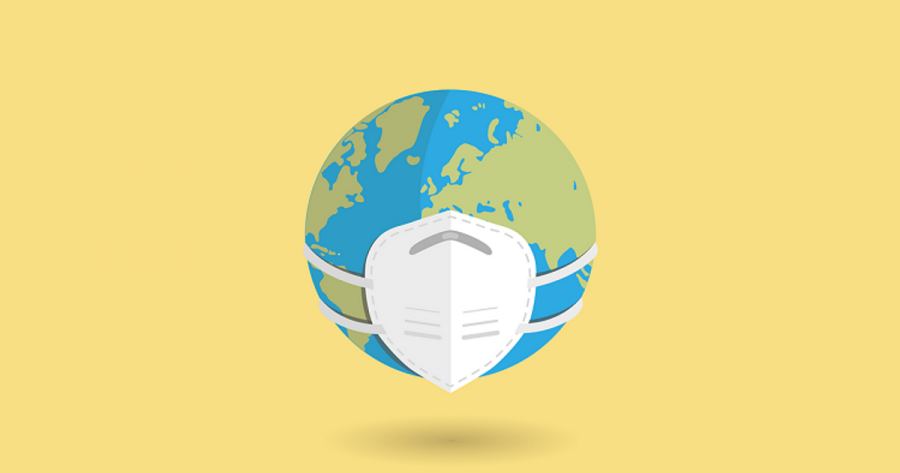The Return to Normalcy
October 29, 2020
As the pandemic drags on, the weeks are blurring together, the days are getting shorter, the weather is getting fouler, and our spirits are sinking lower. Feelings of uncertainty are beginning to plague us more than ever: What comes next? A second wave? Another quarantine? The daunting numbers infecting the news only make it worse: almost 9 million cases, 225 thousand deaths, the highest rate of infection since April. It seems like just yesterday we were marking 100,000 cases, now we’ve more than doubled that in deaths. This is scary stuff: it’s no wonder no one likes to bring it up.
But every day that passes brings us one day closer to the end. Eventually, a time will come when the streets will flood with maskless joy once again, when the bleachers will be filled with roaring crowds, when the phrases “social distancing” and “six feet apart” aren’t a part of our daily vernacular. To get there, though, will be a journey. We all will have to weather the cold and the wind. We will have to huddle together (metaphorically, that is) to brave what will come. It’s only going to get worse before it can get better. But what exactly is to come? Here’s what I think the next year or so will look like.
While many public health experts have been critical of the US response to the pandemic, the global effort as a whole has been nearly flawless. The scientific community has made staggering work in producing a vaccine in a historically short amount of time. The general consensus is that, if everything goes as planned, a vaccine should be approved by the FDA (Food and Drug Association) by early next year. But that’s an enormous “if.” Currently, there are 59 coronavirus vaccines in various stages of trials, with a few almost ready to apply for approval. It’s these few that would be ready by early next year. If these front-runners for whatever reason are delayed, due to safety concerns or monetary restrictions, early next year could turn to spring or summer of next year.
The FDA has explicitly stated it won’t approve any vaccine that is not at least 50% effective in its trials, but even so, trials aren’t perfect. Drugs can react to the body abnormally for those of different race, genetic background, and socioeconomic standing. A certain vaccine could pass its trials with flying colors but be horribly ineffective in the general population because of the homogeneity of its participants. Or worse, a vaccine could have side effects for certain groups, only noticeable far after the trials have ended. The only way to prevent this would be to lengthen the trials, which would inevitably delay the release of a vaccine. No one wants that.
Furthermore, approval by the FDA is only the first step. The next is to convince enough of the population to take it. It may sound odd, but nearly 63% of US adults expressed safety concerns regarding a vaccine, with 40% specifically worrying that its fast-paced development has been too fast, suspiciously fast, in an October poll. The question, therefore, becomes, how do we balance speed with safety? Do we delay a vaccine to be extra sure that it’s safe and effective? Or, do we push forward, pedal to the metal, to release a vaccine as quickly as possible that hasn’t been as thoroughly vetted? As much as all of us want to go back to normal, do we want to risk even more lives with a vaccine that isn’t quite ready and might have unforeseen side effects?
Regardless, let’s estimate conservatively that a vaccine is approved and released by the Spring of 2021. How long is it going to take for production to ramp up enough for the vaccine to be available to the average American? According to Dr. Fauci, not for a while. “We will know whether a vaccine is safe and effective by the end of November, beginning of December… The amount of doses that will be available in December will not certainly be enough to vaccinate everybody–you’ll have to wait several months into 2021.” Furthermore, what will be made of costs regarding this vaccine? Herd immunity doesn’t work unless nearly everyone is immune, and early reports suggest that those without health insurance may end up having to pay out of pocket for a vaccine. The pandemic has caused the unemployment rate to skyrocket, and, although it has somewhat stabilized in recent months, it still is hovering around 8%. Anywhere from 18-25 million Americans are without a job and, therefore, without health insurance. Even if the cost of a vaccine ends up being nominal, the cost of the vaccine is not the only fee. There’s the cost of visiting the doctor and paying for the office visit, taking time off work, and getting to the clinic itself.
There’s still a long way to go on our road back to normalcy. Even when a vaccine is released, it is going to take a while for herd immunity to kick in. So, when do we get back to normal? Some say late next year, others the year after that. Even so, experts say that we would still need to abide by safety protocols like physical distancing and mask-wearing in coordination with a vaccine. According to Dr. Fauci: “We can be helped greatly by vaccine, but it’s not vaccine alone.” He goes on: “There really is no absolute time we can go back to normal unless certain things fall into place. If [they do,] I think we could get the level of infection down so low in the community that by the third quarter end of 2021 we could start thinking in terms of normal.”

